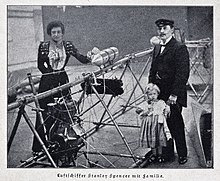Stanley Spencer (aeronaut)
Stanley Edward Spencer (1868–1906) was an early English aeronaut, famous for ballooning and parachuting in several countries, and later for building and flying an airship over London in 1902.
Stanley's family had a history of flying: all his five siblings were also aeronauts, with Arthur and Percival the more well-known; his father Charles Green Spencer pioneered gliding and founded the balloon factory C.G. Spencer & Sons in London; and his grandfather Edward had flown balloons with Charles Green since 1836. On 15 September 1898, Stanley piloted a hydrogen balloon for the meteorologist Arthur Berson in what was believed to be a record ascent to 27,500 feet. On 15 November 1899, Spencer ascended with John Mackenzie Bacon and Gertrude Bacon to observe the Leonid meteor shower from above the clouds. Ten hours later, their balloon landed near Neath, South Wales, narrowly missing drifting out over the Atlantic.
The success of the airships designed and flown by Alberto Santos Dumont in Paris led Spencer to believe that he could build an improved version. To fund the construction costs, he entered into a sponsorship contract with Mellin and Company of Peckham, the manufacturer of "Mellin's Food", a leading brand of infant formula "for babies and invalids". The sum of £1,500 was payable in return for twenty-five return flights carrying an advertisement for "Mellin's Food".
The airship was assembled in Spencer's balloon shed at Crystal Palace, London, then a popular site for balloon ascents. The envelope of the airship measured some 75 feet (23 metres) in length and had a capacity of 20,000 cubic feet (566 cubic metres) of hydrogen. The gondola was an open framework of bamboo poles, on which was mounted a Simms petrol engine of three and a half horse power. There was only space for a single person. The engine drove a wooden propeller which worked in tractor configuration; previous airships had used a pusher configuration, which, being mounted at the back, ran the risk of igniting any escaping gas. A fan pump and valve designed by Spencer replaced any lost gas with air, to prevent the envelope from deforming. A further safety feature was that in the event of a catastrophic failure of the envelope, Spencer claimed that it was designed to collapse into the shape of a parachute.
...
Wikipedia

